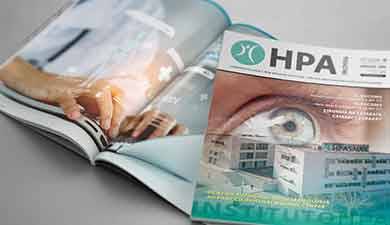Dra. Catarina Cavaco
Pharmacist
Director of Pharmaceutical Services

Rational use of antimicrobials and development of resistance
HPA Magazine 20
The development of antimicrobial agents has represented a great advancement for humanity and is one of the main reasons for the increase in average life expectancy.
Antimicrobial agents are widely used, and at some point, we have all resorted to their use, whether for treatment or prophylaxis of infections caused by microorganisms.

In 1928, Alexander Fleming discovered penicillin while conducting research on staphylococci. Since then, several antimicrobial agents with different mechanisms of action, spectra, and routes of administration have been developed. Scientific advances in this field have allowed optimization in terms of prevention, diagnosis, and treatment of various infectious diseases.
However, the indiscriminate use of antimicrobials in healthcare and large-scale livestock production has favored the selection of resistant microorganisms, resulting in decreased or loss of antibiotic efficacy.
Microbial resistance is the phenomenon in which bacteria, fungi, viruses, or parasites become resistant to the activity of antimicrobial agents through various mechanisms of resistance.
The increase in resistance is associated with more hospitalizations, increased mortality rates, and high healthcare costs.
As a result, some increasingly common diseases, including respiratory tract infections, sexually transmitted infections, or urinary tract infections, become incurable.
According to the World Health Organization (WHO), infections caused by microorganisms that do not respond to antimicrobial treatments already result in nearly 5 million deaths per year.
This number is expected to increase, and studies indicate that it could reach around 10 million by 2050 if effective measures are not adopted to reduce the risk of their occurrence.
To combat these resistances, there is an urgent need to research and develop new molecules. However, this process is becoming increasingly complex and costly. According to the latest WHO annual report, only 12 new antibiotics have been approved since 2017. Out of those, 10 belong to existing classes in the market. Antimicrobial resistances are considered one of the most serious threats to global public health and the future of humanity, alongside climate change and the risk of nuclear conflict.
Although the use of antibiotics can naturally lead to the development of microbial resistance, the inappropriate use of these medications is one of the main factors that accelerate and worsen the occurrence of these resistances.
Therefore, some general principles should be observed in the use of antibiotics by the population:
> Antibiotics are not meant to treat all infections and should not be used excessively (antibiotics only work against bacteria sensitive to a particular antibiotic).
> Antibiotics are not effective against viruses, parasites, or fungi. Therefore, they should not be used to combat all types of infections, such as colds and flu, which are generally caused by viruses.
> Taking antibiotics should be done responsibly and only when prescribed by a doctor.
> All instructions from the doctor and pharmacist should be followed, such as taking the correct dose, respecting the intervals between administrations, and completing the full course of antibiotics.
> Leftover antibiotics should not be used. They should be returned to the pharmacy so they can be disposed of properly.
Health professionals play an extremely important role in promoting the rational use of antimicrobials among the population by following evidence-based practices in prescription, dispensing, and administration, as well as complying with the guidelines on antibiotic use issued by the competent authorities.
Ensuring the effectiveness of antimicrobials is a responsibility shared by everyone.
IN ANIMAL PRODUCTION
Animals can be treated with antibiotics and, as a result, can carry antibiotic-resistant bacteria.Vegetables can become contaminated with antibiotic-resistant bacteria through the use of animal manure as fertilizer. Antibiotic-resistant bacteria can pass from food and direct contact with animals to humans.
IN THE COMMUNITY
Sometimes, humans are prescribed antibiotics to treat infections.
However, bacteria develop resistance to antibiotics as a natural adaptive response. Antibiotic-resistant bacteria can then be transmitted from treated individuals to others.
IN HEALTHCARE INSTITUTIONS
Humans can receive antibiotics in hospitals and subsequently become carriers of antibiotic-resistant bacteria. These bacteria can be transmitted to other patients through dirty hands or contaminated objects.
Patients who may carry antibiotic-resistant bacteria are eventually sent home and can transmit these resistant bacteria to others.
TRAVEL-RELATED TRANSMISSION
Travelers requiring hospital care during a visit to a country with a high prevalence of antibiotic resistance may return home with antibiotic-resistant bacteria.
Even if they don't require healthcare, travelers can be carriers and import antibiotic-resistant bacteria acquired from food or the environment during their journey.








